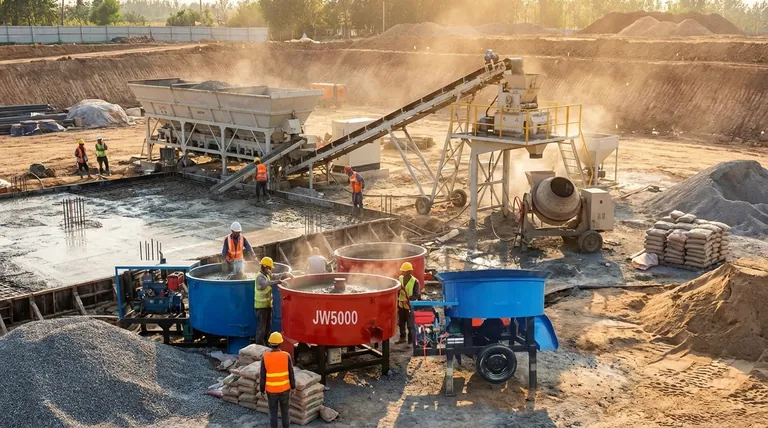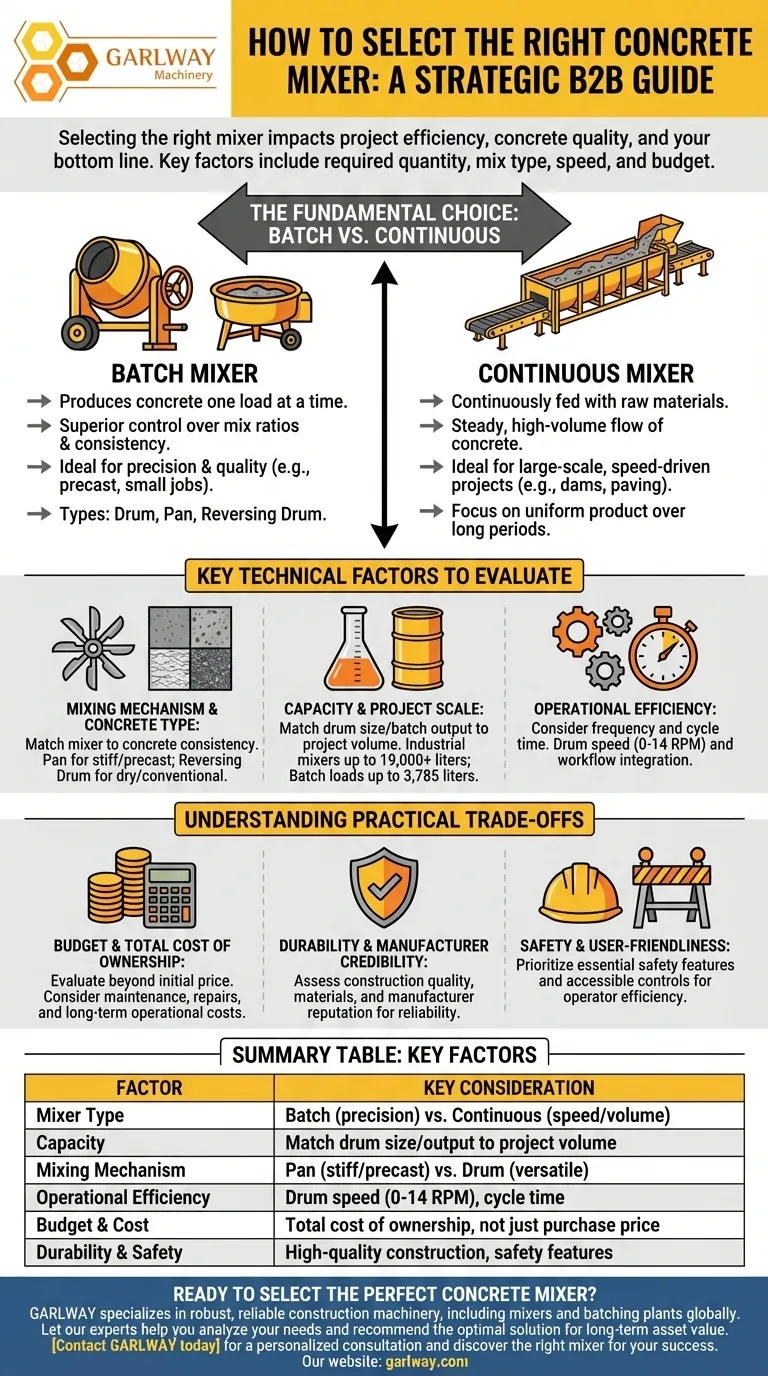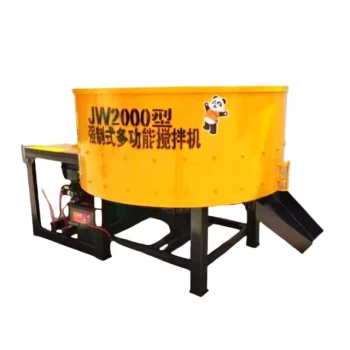Selecting the right concrete mixer is a critical decision that directly impacts project efficiency, concrete quality, and your bottom line. The primary factors to consider are the required quantity of concrete, the specific type of mix, operational demands like speed and precision, and the overall budget.
The core decision is not about a single feature, but a strategic choice between two distinct operational models: batch mixers for projects demanding precision and control, and continuous mixers for those requiring sheer volume and speed.

The Fundamental Choice: Batch vs. Continuous Mixers
Your first and most important consideration is how the concrete will be produced. This choice dictates nearly every other factor.
When to Choose a Batch Mixer
A batch mixer produces concrete one distinct load at a time. This method offers superior control over the mix ratios and consistency of each batch.
They are the preferred choice for projects where quality and precision are paramount. This includes most small-to-medium-sized construction jobs and the production of specialized concrete.
Batch mixers come in several types, including drum mixers (revolving and tilting) and pan mixers.
When to Choose a Continuous Mixer
A continuous mixer is designed for high-volume output. It is continuously fed with raw materials and produces a steady flow of concrete.
These machines are ideal for large-scale operations like dams, paving, or large foundations where speed and efficiency are the primary drivers. They excel at producing a consistent, uniform product for an extended period.
Key Technical Factors to Evaluate
Once you've decided between a batch or continuous system, you must evaluate the specific technical capabilities of the machine.
Mixing Mechanism and Concrete Type
The type of mixer must match the type of concrete you are producing. Different mechanisms are optimized for different consistencies.
Pan mixers are highly effective for stiff, precast concrete due to their intense mixing action. Reversing drum mixers are better suited for dry or more conventional mixes.
Capacity and Project Scale
The mixer's capacity must align with your project's volume requirements. This is measured by the drum size or batch output.
Drum sizes can range significantly, with large industrial mixers holding over 19,000 liters. Batch mixers can handle loads up to 3,785 liters (1,000 gallons), making them suitable for a wide range of jobs.
Operational Efficiency
Consider the frequency of mixing and the machine's ability to keep up with your workflow without causing delays.
Key metrics include the drum speed, which typically operates between 0-14 revolutions per minute, and the overall cycle time for batch mixers.
Understanding the Practical Trade-offs
A technically perfect machine may not be the right choice if it doesn't align with your business realities.
Budget and Total Cost of Ownership
Your evaluation must go beyond the initial purchase price. Consider the total cost of ownership, which includes maintenance, repairs, and operational costs.
A cheaper machine may have higher long-term costs if it requires frequent maintenance or is less durable.
Durability and Manufacturer Credibility
The longevity of a mixer is determined by the quality of its construction and the materials used.
Investigate the manufacturer's production standards and reputation. A credible manufacturer using high-quality materials will produce a more reliable and durable machine.
Safety and User-Friendliness
Modern mixers should be equipped with essential safety features to protect operators.
Additionally, user-friendly controls and accessible maintenance points can significantly improve operational efficiency and reduce downtime.
Making the Right Choice for Your Project
Choosing a concrete mixer is a strategic investment. Match the equipment's capabilities directly to the demands of your specific application.
- If your primary focus is high-volume output for large infrastructure: A continuous mixer is the most efficient choice to ensure a steady supply of concrete.
- If your primary focus is producing high-quality, specialized precast concrete: A pan-type batch mixer offers the necessary control and powerful mixing action for consistent results.
- If your primary focus is versatility for various small to medium-sized jobs: A reliable reversing drum batch mixer provides the best balance of precision, cost-effectiveness, and flexibility.
This methodical approach ensures your equipment becomes a strategic asset that enhances productivity, rather than a project liability.
Summary Table:
| Factor | Key Consideration |
|---|---|
| Mixer Type | Batch Mixer (precision) vs. Continuous Mixer (speed/volume) |
| Capacity | Match drum size or batch output to your project's volume needs |
| Mixing Mechanism | Pan mixer (stiff/precast) vs. Drum mixer (versatile mixes) |
| Operational Efficiency | Consider drum speed (0-14 RPM) and cycle time to avoid delays |
| Budget & Cost | Evaluate total cost of ownership, not just the initial purchase price |
| Durability & Safety | Prioritize high-quality construction and essential safety features |
Ready to Select the Perfect Concrete Mixer?
Choosing the right equipment is a strategic decision that impacts your project's efficiency, quality, and budget. GARLWAY specializes in providing robust and reliable construction machinery, including a wide range of concrete mixers and batching plants tailored for construction companies and contractors globally.
Let our experts help you analyze your specific needs to recommend the optimal solution. We ensure you get a machine that enhances productivity and becomes a long-term asset.
Contact GARLWAY today for a personalized consultation and discover the right mixer for your success.
Visual Guide

Related Products
- Ready Mixer Machine for Construction Ready Mix Machinery
- Commercial Construction Mixer Machine for Soil Cement Mixing Concrete
- Auto Concrete Cement Mixer Machine New
- Construction Products Concrete Plant Machine Mixing Concrete Mixer
- HZS90 Large Multiquip Concrete Mixers for Construction
People Also Ask
- Why is the manufacturer's strength and service important when choosing a concrete mixer? Ensure Long-Term Project Success
- Why is cleaning a concrete mixer after use important? Avoid Costly Repairs and Ensure Quality
- Can a concrete mixer be used for mortar? Understanding the trade-offs for your project
- When was the first concrete mixer developed and by whom? Discover the 1900 Breakthrough
- What is the average lifespan of a concrete mixer? Maximize Your Equipment's Lifespan & ROI



















